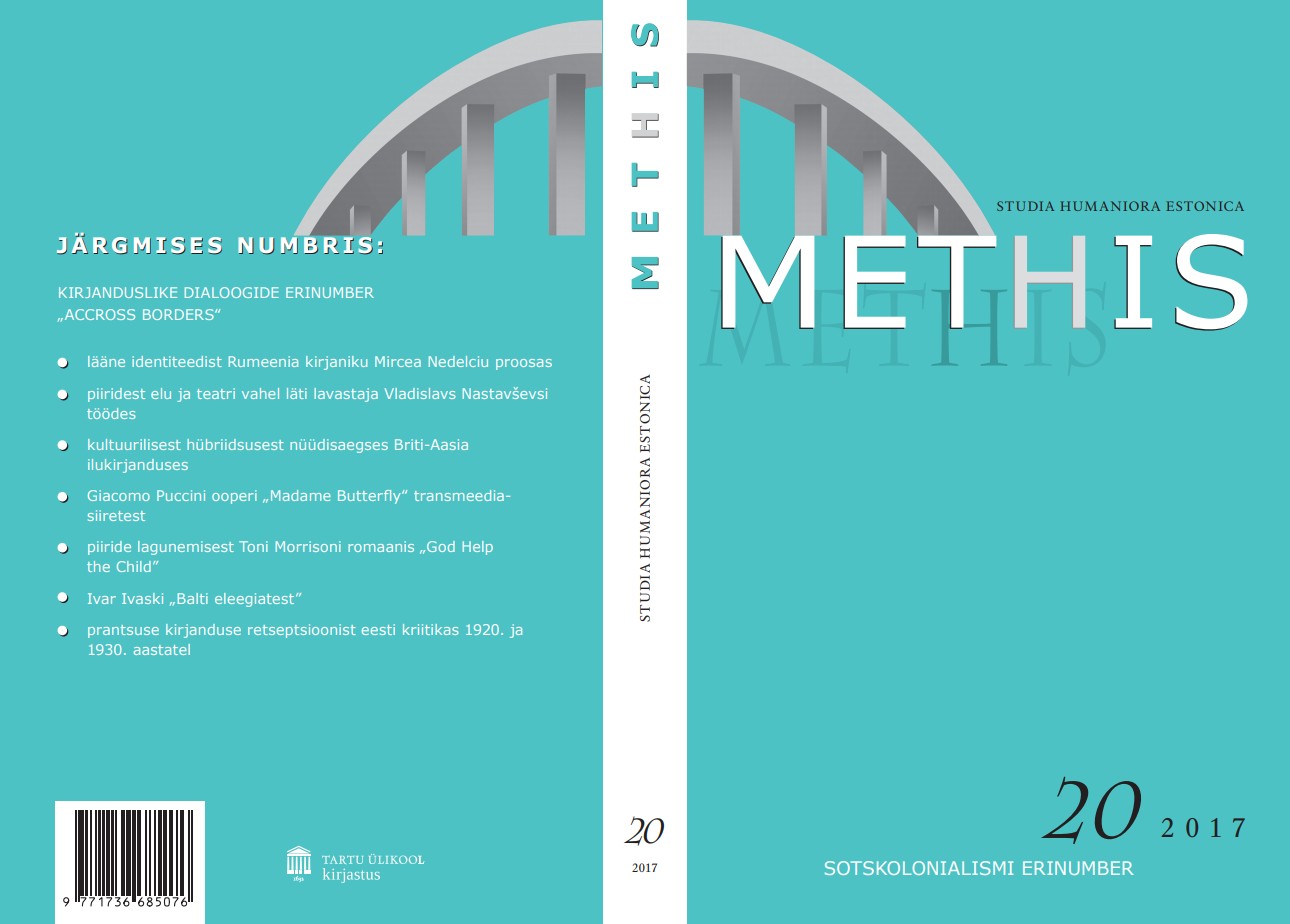Regilaul tuulte pöörises. Eesti folkloristika poliitiliste muutuste ajajärgul 20. sajandi keskel / Regilaul in the whirlpool. Estonian folkloristics during the political changes in the middle of the 20th century
DOI:
https://doi.org/10.7592/methis.v16i20.13888Keywords:
kolonialism, stalinism, teaduspoliitika, rahvusteadused, folkloristika, regilaulud, colonialism, science policy, national sciences, folkloristics, runo songsAbstract
Artikli eesmärk on jälgida regilaulu kui Eesti folkloristika paraadžanri käekäiku Eesti sovetiseerimise ajajärgul 1940.–1950. aastatel ja selle kaudu eesti folkloristide kohandumisi muutuva teaduspoliitikaga. Kuna sõjajärgset Eestit võib lugeda koloniseerituks Nõukogude Liidu poolt, tuvastatakse sotskolonialismi tunnuseid Eesti sõjajärgses folkloristikas. Vaatluse alla võetakse regilaulu muutuv positsioon ametlikus retseptsioonis ning folkloristlikel välitöödel. Kuna nõukogude ajajärku esitatakse sageli eesti rahvakultuuri õitseajana, vaadeldakse lähemalt rahvaloomingu viljelemist harrastajate ja professionaalsete kunstnike tasemel, rahvusliku vormi sotsialistliku sisuga täitmist.
The purpose of the paper is to follow how Estonian folklorists adapted changing science policy in the 1940s and 1950s, and how an elite genre of the Estonian folklore – regilaul – was treated in the course of the Sovietization of Estonian humanities and cultural life.
There are several distinctive features of the Soviet colonization in the post-war Estonian folkloristics. First, an extensive reform of the organization of the academic institutions took place in annexed Estonia, following the example of organizational structures in Soviet Russia’s Academy of Sciences.
The most specific feature of the Soviet colonialism was the extremely strong dependence of the peripheries on the colonial centre. Academic life in Estonia was guided by the resolutions of the Communist Party of the Soviet Union, which were observed and monitored closely by local authorities at the plenary meetings of the Estonian Communist Party and further discussed at the meetings of local academic institutions. These discussions were followed by waves of reassessments, (self) criticism and repressions. Folklorists from the Baltic republics were supervised and “assisted” by Russian folklorists in terms of the methods of the Soviet folkloristics at the union-wide conferences held in Moscow, the Soviet colonial centre. Direct models were taken over to reorganize folkloristic fieldwork and research in the spirit of the new ideology.
The third specific feature of the Soviet colonialism was the adaption of Soviet pidgin, colonial discourse, which proliferated especially during the last years of the Stalinist era, from 1948 to 1953. Research in any discipline was limited by the Marxist method; any deflection in it was considered renegade and therefore punishable. In Estonian folkloristics, however, the mastering of the Marxist method comprised largely of clever usage of the colonists’ slogans and formulae, such as “bourgeois-nationalist”, “formalism”, “cosmopolitanism” versus “internationalism”, “objectivism”, and “anti-patriotic” etc. Oft-repeated labels carried no actual meaning; far from any rationale, they were rather formulaic weapons of fighting with enemies, tools of revaluing and (self) criticism. In the end of the 1950s, the use of most grievous lexis declined, but in general, the Soviet discourse was adapted.
The altering position of regilaul in the folkloristic writings and fieldwork is discussed in the paper. The last years of the Stalinism, the hierarchy of the folklore genres was turned upside down and classical folklore genres were marginalized because mainstream Soviet folkloristics were focused on contemporary “Soviet folklore” and amateur cultural activities. Estonian folklorists adapted the new reality expeditiously, implementing a sort of mimicry. Fieldwork was carried on in areas with vivid traditional culture, such as Setumaa and Kihnu Island, using the collection of Soviet folklore as pretext. Folklorists did not change their collecting methods and continued to collect traditional folklore genres. Examples of contemporary “folk creations” were documented randomly and unsystematically; all the more were these findings proudly brought before the public at the union-wide forums and in the local press. In these years, curiosa like eulogies to the Lenin and Stalin, collective farms and the Soviet Army in the form of regilaul were documented.
After the death of Stalin, Estonian folklorists returned to the classical folklore genres, though overemphasizing the motifs of “class struggle” and “heroism of the working crowds” in the old oral poetry.
Due to the existing stereotypes regarding favouring ethnic minorities and folk culture under the Soviet regime, the paper takes a closer look to the use of folklore or/and folk creations at both the amateur and professional level of cultural activities. Although Soviet propaganda hailed the blossoming of the folk cultural activities, not all branches of the folk culture were allowed to blossom. Certainly, “folk” and “national” cannot be seen as synonyms. The concept of folklore was blurred because of the parallel concept of folk creations, which included non-traditional cultural activities. Folklorists were forced to deal with amateur cultural activities. In the professional level, the slogan of “socialist content in national form” marked deterioration, simplification and impoverishment regarding means of artistic expression. Instead of folklore pieces, the national epic “Kalevipoeg” was used as an exemplary to the professional artistic creations. Because of sophisticated stylistic features and lyricist mood of regilaul, conflicting to the Soviet aesthetics, becoming inspired by the regilaul tradition was out of the question for artists of the Stalinist era. Enforced simplicity and conservatism caused innovation in literary and musical creations in 1960s, broadening the use of regilaul in professional culture.


